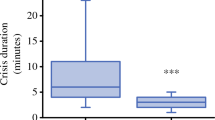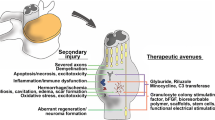Abstract
We present the case of cardiac arrest in a patient with neurally mediated syncope (NMS). A 66-year-old male patient was scheduled to undergo right inguinal hernioplasty. He had a history of syncope, which occurred a few times a year in childhood and once a year recently. One minute after the second spinal injection, cardiac arrest (asystole) developed. Sinus rhythm was restored by cardiac massage and intravenous administration of atropine and ephedrine. The operation was cancelled. The patient was diagnosed as NMS by a cardiologist. Four months later, right inguinal hernioplasty was performed, uneventfully, under general anesthesia. High sympathetic blockade due to spinal anesthesia and transient withdrawal of sympathetic tone and increase in vagal discharge due to NMS could be the main causes of the cardiac arrest. If the patient has any possibility of NMS, anesthesiologists should consider the possibility of cardiac arrest after spinal anesthesia.

Similar content being viewed by others
References
Zaqqa M, Massumi A. Neurally mediated syncope. Tex Heart Inst J. 2000;27:268–72.
McConachie I. Vasovagal asystole during spinal anaesthesia. Anaesthesia. 1991;46:281–2.
Molnar J, Somberg JC. Neurocardiogenic syncope. Cardiology. 2009;114:47–9.
Pollard JB. Cardiac arrest during spinal anesthesia: common mechanisms and strategies for prevention. Anesth Analg. 2001;92:252–6.
Guise PA. Asystole following propofol and fentanyl in an anxious patient. Anaesth Intensive Care. 1991;19:116–8.
Ebert TJ. Sympathetic and hemodynamic effects of moderate and deep sedation with propofol in humans. Anesthesiology. 2005;103:20–4.
Fukuda K. Intravenous opioid anesthetics. In: Miller RD, editor. Miller’s anesthesia. 6 ed. Philadelphia: Churchill Livingstone; 2005. p. 379–437
Yamazaki M, Stekiel TA, Bosnjak ZJ, Kampine JP, Stekiel WJ. Effects of volatile anesthetic agents on in situ vascular smooth muscle transmembrane potential in resistance- and capacitance-regulating blood vessels. Anesthesiology. 1998;88:1085–95.
Picker O, Scheeren TW, Arndt JO. Inhalation anaesthetics increase heart rate by decreasing cardiac vagal activity in dogs. Br J Anaesth. 2001;87:748–54.
Connolly SJ, Sheldon R, Thorpe KE, Roberts RS, Ellenbogen KA, Wilkoff BL, Morillo C, Gent M, Investigators VI. Pacemaker therapy for prevention of syncope in patients with recurrent severe vasovagal syncope: Second Vasovagal Pacemaker Study (VPS II): a randomized trial. JAMA. 2003;289:2224–9.
Brignole M, Sutton R. Pacing for neurally mediated syncope: is placebo powerless? Europace. 2007;9:31–3.
Alboni P, Brignole M, Degli Uberti EC. Is vasovagal syncope a disease? Europace. 2007;9:83–7.
Author information
Authors and Affiliations
Corresponding author
About this article
Cite this article
Ishiyama, T., Shibuya, K., Terada, Y. et al. Cardiac arrest after spinal anesthesia in a patient with neurally mediated syncope. J Anesth 26, 103–106 (2012). https://doi.org/10.1007/s00540-011-1264-7
Received:
Accepted:
Published:
Issue Date:
DOI: https://doi.org/10.1007/s00540-011-1264-7




